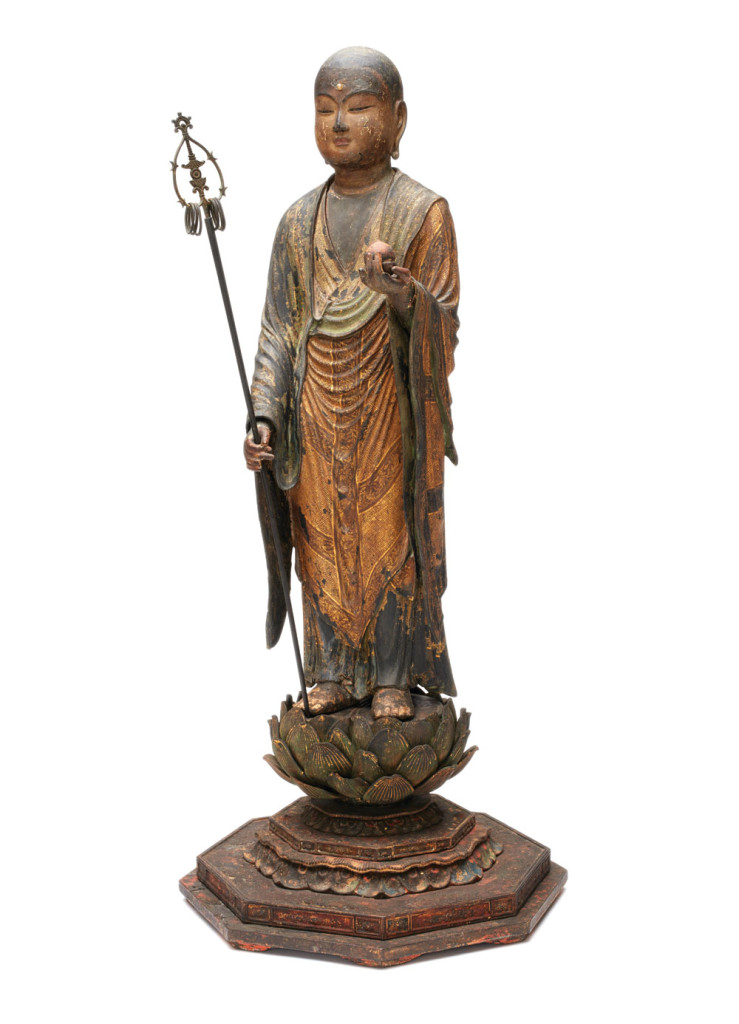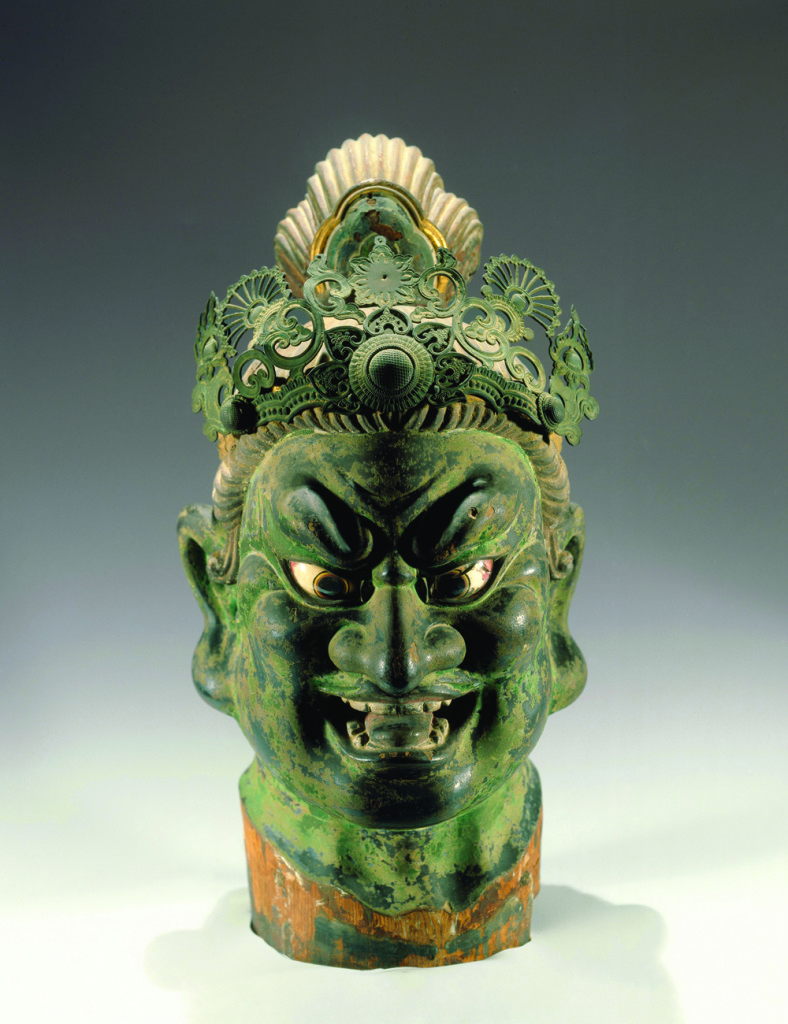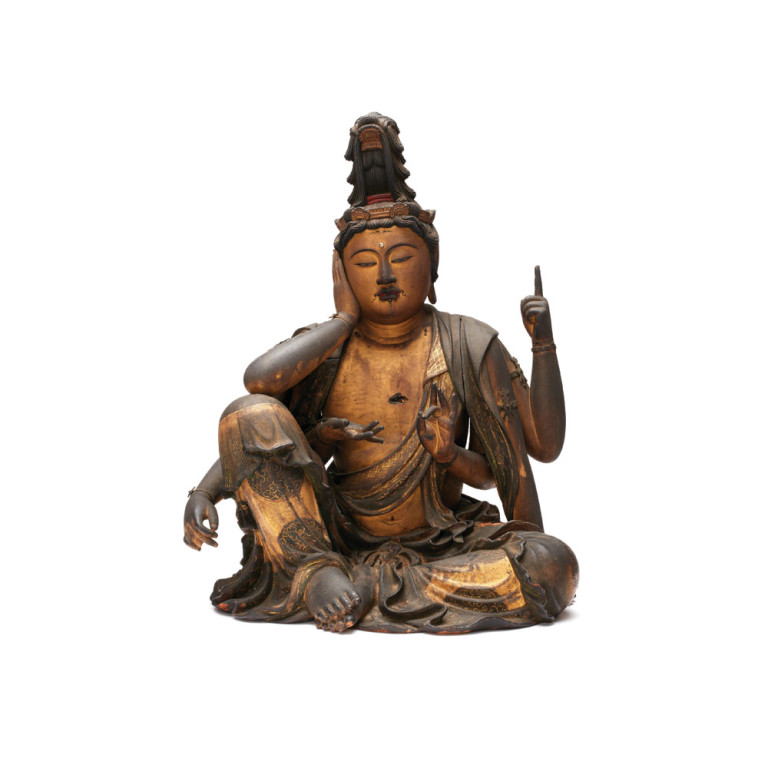Japan’s Kamakura period (1185–1333), which both began and ended in civil war, lasted barely 150 years, but the era’s artistic, political, and religious developments had an outsized influence on Japanese culture for many centuries following. Kamakura painted-wood sculpture, in particular, is famous for its beauty, its craftsmanship, and its extraordinary—and at times alarming—realism.
The Asia Society’s dazzling show of Kamakura Buddhist sculpture, conceived by guest curator Ive Covaci and the Asia Society’s Adriana Proser, was the first to be mounted in the United States in over 30 years. Comprising fewer than 40 well-chosen pieces, the exhibition presented them not only as works of art but also, for devotees, as potent stand-ins for the deities depicted. While these images are of otherworldly beings, they have a vividness of presence that befits their role as aids to meditative visualization.
The Genpai War of the 1180s pitted the powerful Minamoto and Taira warrior clans against each other over control of the imperial court. The Minamoto clan prevailed, and Minamoto Yoritomo became the first ruling shogun of Japan, establishing a military government centered in Kamakura, just south of Tokyo. In this moment of conflict and change, Japanese art entered into a new phase.
A precipitating factor was the burning of the stunning 8th-century temples at Nara by Taira forces during the war and the great rebuilding that followed. Replacement icons were needed in quantity, and in making them, sculptors revived the 8th-century naturalistic style of the originals, improving on it with a number of technical innovations. The greatest of these was joined woodblock construction, which allowed for larger and more dynamic representations of saints and deities. (The hollow blocks also made possible the ritual filling of the figures’ interiors with offerings and prayers, a practice that strengthened the connection between icon and practitioner.) Another innovation was the use of crystal lenses for the figures’ eyes. Painted from the back by specialized craftsmen, they would have glittered convincingly in lamp-lit temples.
The impression of movement is an earmark of sculptures of this time. It is especially pronounced in a figure of Bishamonten, one of the four Buddhist Heavenly Kings, a guardian of the north (as indicated by the small model of a pagoda in his left hand) and a deity invoked by Minamoto Yoritomo himself to help bring success in battle. Round-faced and hard-bodied, Bishamonten stands slightly hipshot on the backs of two demons, his sleeves and the back of his cloak fluttering in an unseen wind.

A subtler kineticism is displayed in a gently curving figure of the bodhisattva Jizo, his body tipped forward and his shoulders set back, by the sculptor Kaikei (1183–1223), and in a depiction of the folk deity Gushojin dressed in Chinese robes (Chinese influences show up throughout the exhibition, Japan in this period having recently reestablished relations with the rest of Asia). With his feet planted and his hands in fists, he’s the picture of determined solidity.
Kamakura sculptors like Kaikei signed their works for the first time in Japanese history, while a new group of patrons emerged from the warrior elite. In addition to several works by Kaikei, pieces by other famous artisans of the era are on view here, including Koshun’s serene depiction of the Shinto deity Hachiman (a tutelary god of the Minamoto clan) in the guise of a Buddhist monk, and a standing Jizo by Zen’en, an artist known for his figures’ sweetness of countenance. On the inside of the latter sculpture is written one thousand repetitions of the seed syllable for Jizo, signifying the bodhisattva’s ability to be in all places at once. An additional inscription, however, suggests that this work is associated with the Shinto Kasuga Shrine in Nara, and the piece is thought to be one of a set of five Buddhist images by Zen’en, which correspond to five native deities (kami) seen at the Kasuga shrine.
Works such as these illustrate the survivals and crossovers that characterize much religious sculpture of the Kama-kura period. Mahayana Buddhism, with its ideal of compassion for all sentient beings, was introduced in Japan from China around 550 C.E.; by the 12th century, Mahayana’s esoteric Vajrayana form, with its elaborate rituals and pantheon of peaceful and wrathful deities, had become the dominant practice for both the old aristocracy and the new warrior class. But the Kamakura era also saw the emergence of new Buddhist movements, among them Zen—freshly arrived from China and appealing greatly to the military mind—as well as populist movements based on Pure Land Buddhism that promised salvation through the recitation of the name of Amida Buddha.

This religious pluralism is reflected in the exhibition, which includes images of Amida (one is of a standing Amida, a form unique to Kamakura art), the esoteric wrathful deity Aizen Myoo (as a three-inch-high whirlwind of concentrated energy), Kannon (seen here deep in meditative contemplation, but with six busy arms signifying his activity in the world), and Miroku, the future Buddha. The disciples of this latter deity believed they were living in a time when Buddhism was in decline; Miroku offered them a heaven to wait out his rebirth.
Peculiar to Japanese Buddhism were the magical powers attributed to particular sculptures. Myths grew up around local icons that were said to have performed miracles, and these icons were often copied. The show ends with a spectacular example of one such copy: a Jizo Bosatsu by the sculptor Koen (1207–after 1275). Originally thought to have been an earlier work, it was found to be packed with materials, including a dedicator document explaining that it was a replica of a statue that had escaped fire of its own accord. It’s a breathtaking synthesis of faith and craft, like all the objects in this small but important show.
Thank you for subscribing to Tricycle! As a nonprofit, we depend on readers like you to keep Buddhist teachings and practices widely available.
